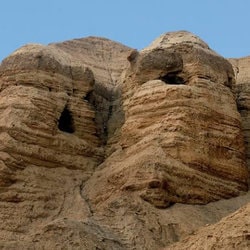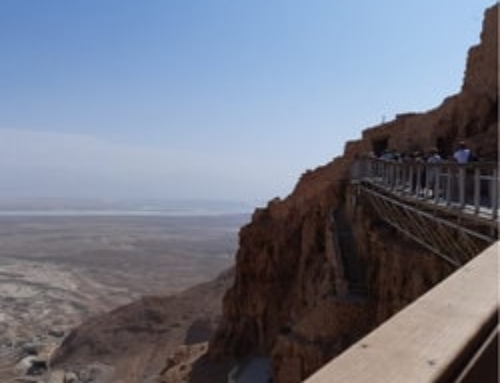 Whether you arrive from Tel Aviv or Jerusalem, you’ll get the same surprise: the Judean Desert is rich in archaeological sites and mini-oasis! Going from the Kalya and Ein Gedi Kibbutzim, major parts in the history of the creation of the State of Israel, or to Qumran, Ein Gedi and Massada, you’ll go from surprise to surprise!
Whether you arrive from Tel Aviv or Jerusalem, you’ll get the same surprise: the Judean Desert is rich in archaeological sites and mini-oasis! Going from the Kalya and Ein Gedi Kibbutzim, major parts in the history of the creation of the State of Israel, or to Qumran, Ein Gedi and Massada, you’ll go from surprise to surprise!
All of these wonders are along the very well known Dead Sea as far as the Mountain of Salt , Mount Sodom…. So, are you ready to set off on an adventure?
The Judean Desert Kibbutzim
If you’ve never heard of them, the Judean Desert region Kibbutzim are among the best in the country, they include the Almog, Kalya and Ein Gedi Kibbutzim. They are always open to the public and like visitors to discover their way of life and innovative agricultural methods. A Kibbutz is a sort of village based on collective living and Zionist ideology brought by Russian Jews who arrived in the country at the beginning of the 20th century. Each one, depending on the period in question, has played a more or less crucial role in the country’s history. For example, if one is interested in the Kalya Kibbutz , it was initially a work camp set up by the British.
A few years later it was transformed into a hotel complex with a SPA on the Dead Sea. This was made possible by the Kalya Society which tried to encourage tourism to the region in the thirties. Finally, at the beginning of the War of Independence (1947), it was decided to close the structure until the sixties. It was only after the Six Day War that the Kibbutz was really set up at this place.
So don’t delay if you’d like to discover life in a Kibbutz, their customs, their history and development along with innovations they have made in the agricultural sector. The doors of the Kalya and Ein Gedi Kibbutzim will always be open to you!
Qumran: caves and parchments
Do you have an interest in the Dead Sea Scrolls in the Judean Desert? On the north-west plain of the Dead Sea, near the old Qumran river, is a series of very old caves in which were found parchments dating back several centuries. They were written between the third and first centuries BC and in several languages : Hebrew, Greek and Armenian. They are the oldest original Biblical writings discovered up to now.
These parchments can be divided into 3 categories: Old Testament textes, textes from other books outside the Old Testament (like the Book of the Hasmoneens for example) and textes from the well known “Qumran Sect” (Esseniens). The story is that these caves were discovered in 1946 by chance by a young Bedoiun, who was searching for a lost goat.
The site is important in christianity because through the sect’s way of life ( which for some is the primitive forerunner of Christianity), pilgrims can discover how John the Baptist and Jesus lived in this region. Also, the site isn’t far from the Baptism site on the Jordan, where tourists from all over the world come (Qsar El Yehud).
Ein Gedi : an oasis
Would you be interested in walking in the same area as the most well known king in the world? Nothing could be easier, just go to the Ein Gedi oasis! King David, before he officially became king, was forced to hide there for several days in order to save his life. The story goes that King Saul feared so much that David would take his place that he bacame ill and close to madness. Since David didn’t want to usurp Saul, he had to go into exile to save his own life. So he wandered in the desert until he arrived at this beautiful oasis…
As well as walking in King David’s footsteps, when you arrive you could go to the path named after him : Nahal David which winds through the torturous desert mountains that overlook Ein Gedi oasis. The water has been there for millions of years and continues to flow to the delight of visitors. As soon as you arrive, look up at the tree branches, you might see a ibex or two….
Masada Fortress
If you haven’t had the chance to see a fortress, here’s one for you! Masada is a fortified town surrounded by ancient fortifications. It is all set on an immense block of granite edged by reddish cliffs.
Two thousand years ago, it was almost impossible to get there on foot. The Romans had to build, over several months, ramps to try to reach the summit. The history that you’ll discover is terrible yet grandiose! To understand what you’ll find there, you need to know who lived there. At that time, the jews from Jerusalem had found refuge in Masada with their Sicarian Jewish brothers, who already lived there because the beautiful city of Jerusalem had fallen to the Roman emperor Titus.
Initially just a simple fortified garrison for the Hasmonean chiefs, the city of Masada was built by King Herod, who liked grand buildings such as those in Caesaria, the Temple in Jerusalem, Hevron with the Patriarchs’ cave and also Herodion. It has a SPA, a palace, a theatre, food warehouses, a huge water system, mikves (purification baths) and even a synagogue. If you’d like to have a wonderful,calming Israeli experience, try to arrive at the summit a few minutes before sunrise! You’ll have an amazing view over the Judean Desert, the Dead Sea and Jordan along with the calm slence of the desert at dawn….
The Dead Sea
Are you tempted by the thought of floating in a sea of salt? If so, come to the Dead Sea! This “sea”, which forms part of the eastern border with jordan, is definitely the most salty sea: almost 28% salt compared to 3% in the seas in the rest of the world. You’ll be surprised to discover that you can float in the water because of the high salt content. At the Dead Sea, you’ll be at one of the lowest points in the world: -422 metres below sea level!
Why is it called “The Dead Sea”? Simply because there’s almost no living thing in it and it is literally “dying of thirst”; each year its water level drops by almost 2 metres and over the next 25 years, it could disappear altogether. With the Dead Sea decreasing a bit more every year and due to its composition, the ground supporting it often ends up crumbling.
We recommend that you go to the SPA centre in Ein Gedi or to the Dead Sea public beach in order to be more secure. Once you’re at the water’s edge, dig a little into the Dead Sea sand and you’ll find Dead Sea mud that will make your skin as soft as a baby’s! For those with skin diseases, the Dead Sea salt and mud ease the pain of psoriasis and eczema. So swimming costume on, flippers on …and into the water!
Mount Sodom
If you have read about Abraham in the bible, you will have noticed his good, generous character, always ready to help or save anyone in need. One famous story tells of him “negociating”the fate of the cities of Sodom and Gomorrah with God. Finally, after trying to save everyone, he only succeeded in saving the family of his nephew, Lot. However, when his wife turned around to see her city being destroyed, she was immediately turned into a pillar of salt… Now, the exact location of these two cities isn’t known. There are many theories about this but given the region’s geology, it’s generally believed that the city of Sodom is south of Masada, opposite the Dead Sea.
Once you get there, there are many possible circuits so choose the one that suits you the best! In any case, what you walk on won’t be sand or earth dunes like in the rest of the Judean Desert but salt dunes! You’ll cross furrows of every colour carved out over thousands of years and find fossil rocks with fish skeletons…and at times will be overlooking the entrance of caves with salt stalactites! At the end of the circuit, you’ll have to try work out where “ the salt statue of Lot’s wife” is!


Leave A Comment